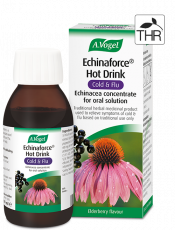What is Echinacea?
Echinacea is a flower from the daisy family with a spiky cone surrounded by long purple petals. You have likely seen it in various places on this website, as it is our A.Vogel flagship herb. It is Native to North America but now grows all over Europe, and lives in many gardens here in the UK and Ireland.
To make this beautiful plant into the herbal product you see on the shelves, we make a tincture. We harvest the flowers, leaves and stems, and dig up the roots, chop them all up and cover the plant material with alcohol and let it steep for a couple of weeks. The roots we use are three years old as it has been found that the medicinal phytochemicals in the roots are most potent after giving them three years to grow!
Medicinal alcohol is a great medium for extracting the healing phytochemicals in the plant. This also preserves them for our use all year round. This is what we call a tincture and this tincture is then made into other products like tablets and sprays.
Is Echinacea good for colds and flu?
Whether it's just a tickle in throat or a full-blown sneeze fest, Echinacea can stop a cold. Here is what some of the science says.
In 2011, a study tested various strains of human and avian influenza viruses, the herpes simplex virus, respiratory syncytial virus, and rhinovirus.2 All these viruses were very sensitive to a standardised Echinacea purpurea preparation.
There were similar findings from a study carried out at the Cardiff Common Cold Centre in 2012.3
This was a randomised, double-blind, placebo-controlled trial, involving healthy volunteers over 18 years old, with a history of 2 or more colds per year. It was the largest and longest clinical trial on Echinacea to date, with 755 patients. They took three daily doses of Echinacea for four months, and the researchers found that Echinacea reduced the number of colds people got. It also reduced the number of days when people experienced cold symptoms.
In the study, the participants in the placebo group that didn't take any Echinacea got 26% more colds. And those not taking Echinacea were 59% more likely to get a second cold. In other words, taking Echinacea protects you even more against recurrent infections!
This shows that Echinacea is great at stopping viral infections in their tracks, as well as supporting the immune system so that colds don't develop in the first place! It also shows how taking Echinacea regularly can reduce the need for painkillers even if a cold does develop.
Those who were most at risk of infection benefitted most. People prone to more than 2 colds per year, people with high-stress levels, smokers and poor sleepers were all considered most at risk. So, if you fall into that second category, Echinacea will help you even more!
How does Echinacea help the immune system?
Echinacea has antiviral and antibacterial properties and can help stop a cold by killing the infection. Echinacea is also anti-inflammatory and can reduce inflammation in cells infected by a virus.4 Echinacea also reduces the number of inflammatory chemicals produced in the body. These chemicals can cause the typical symptoms of the common cold – sneezing, coughing, runny nose, stuffy nasal passages, etc. Balancing their production allows the immune system to work effectively without triggering unpleasant symptoms.5
A group of plant chemicals in Echinacea called alkylamides have a powerful effect on our immune system. They help the body to get the immune-fighting white blood cells to the site of infection even faster. This may be one of the ways it keeps colds at bay, by getting to the virus to kill it off before we ever experience any symptoms.6
Another way that Echinacea can help the immune system is by reducing the bacterial adhesions that are often the cause of secondary bacterial infections after someone is exposed to a virus. It also seems to be able to inhibit inflammation super-stimulation, which is also known as a cytokine storm.7
How much Echinacea should I take for a cold?
The dosages vary depending on the product, so check the packaging for the required dosage. The most important thing about how to take Echinacea is that a regular dose is more helpful than a larger dose, once you are already sick. Two to three times a day is generally recommended for ongoing use. But it is important to take a more regular dose, up to five times a day, at the first onset of any symptoms and throughout an active infection.
My Top Tip:

Echinaforce® Echinacea drops are a traditional herbal remedy used for the symptomatic relief of colds, influenza type infections and similar upper respiratory tract conditions.
"This is a brilliant product all round and have used these for many years"

My Self-Care Tip: How do you take Echinacea for a cold?
The best way to take Echinacea tincture is by adding the recommended amount of tincture into a small glass of water and drinking it! Here's a short video I made to show you how to take Echinacea to stop a cold!
The importance of the whole plant
A final word on Echinacea, the type of extract you use is important. Some products use only the root, and others use the whole plant. Some extracts are dried, while others are fresh. If you are looking for an antiviral remedy, in particular, make sure to find a whole plant extract using the upper parts of the plant as well as the root. A 2013 study examined all the various parts of Echinacea purpurea for their actions.8 They showed that the root is strongly anti-inflammatory whilst the flowers, leaves and stem demonstrated the antiviral activity. Similarly, it is important to know that up to 90% of the antiviral activity is lost if Echinacea is dried. So, if you want to take Echinacea to stop a cold, make sure to take a fresh extract of the whole plant.
References
2. Hudson J, Vimalanathan S. Pharmaceuticals 2011; 4: 1019-1031
4. Hudson J, Vimalanathan S. Pharmaceuticals 2011; 4: 1019-1031
5. Sharma M et al. Phytotherapy Research 2009; 23 (6): 863-7
6. Gertsch J et al. FEBS Letters 2004; 577: 563 –569
7. Vimalanathan S et al. Virus Research 2017; 233: 51-59
8. Vimalanathan S et al. Journal of Applied Science 2013; 3 (12): 001-005








